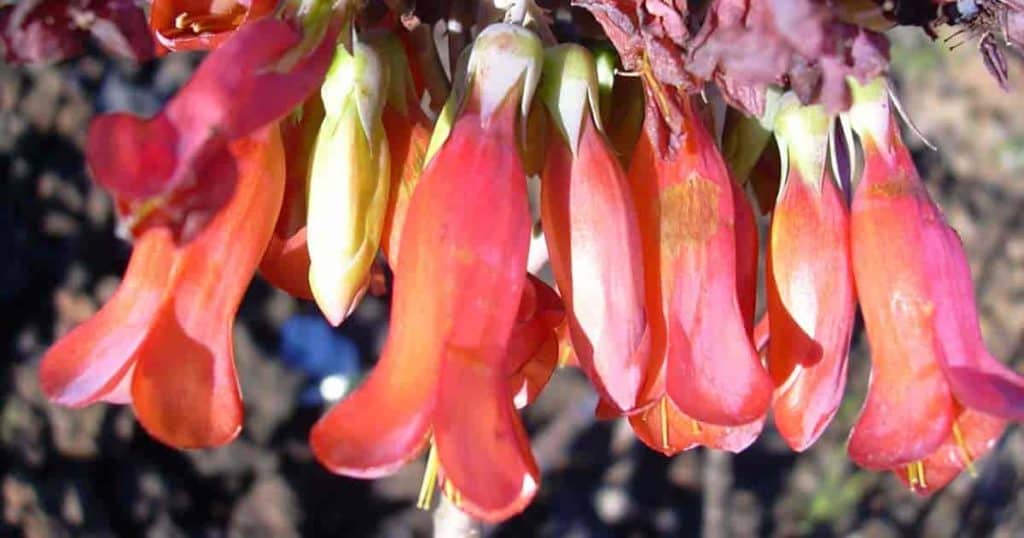Mother of Millions – Kalanchoe tubiflora (kal-un-KOH-ee too-bih-FLOR-uh) is a succulent plant known as the Chandelier Plant.
It belongs to the Bryophyllum genus and family Crassulaceae. It is native to Madagascar but naturalized in Uganda and Tanzania as well.

Other synonyms for tubiflora include:
- Kalanchoe verticillata
- Kalanchoe delagoensis
- Bryophyllum tubiflorum
- Bryophyllum verticillatum
- Bryophyllum delagoense
The name comes from the distinctive appearance of the leaves with their ‘Teeth” and tiny plantlets along the edges that shed millions.
It is in season all year round and grows easily, making it a popular choice.
NOTE: Another Kalanchoe by the common name “Mother of Thousands plant,” Kalanchoe Daigremontiana has wider leaves than tubiflora.
Kalanchoe Tubiflora Care
Mother of Millions Flower Size and Growth
Mother of millions flower is a fast-growing upright plant with single stem growth.
It is typically between 20″ to 28″ inches tall. However, it can grow to 3′ feet tall.
The tubular-shaped leaves can be as long as 2″ to 5″ inches.
Flowering and Fragrance
Bell-shaped flowers in many colors grow in circular clusters at the top of the plant.
These succulent flowering plants have drooping flowers with individual stalks.
Blooms are pale salmon pink to brighter reddish orange but have no fragrance.
Light and Temperature
This bright light loving plant enjoys a sunny spot but is sensitive to the full intensity of midday sun through the glass.
If the plant experiences leggy growth with pale leaves and less marbling, give the plant more sunlight.
However, protect the plant from direct, harsh sunlight.
Mother of Millions thrives best in temperatures ranging from 60 to 85 degrees Fahrenheit.
Watering and Feeding
Bryophyllum tubiflorum is very drought tolerant. However, it does best with regular watering once or twice per week from the spring to fall and less in winter.
Avoid overwatering and remember not to let the pot stand in excess water.
If leaves begin to droop and shed premature young plants, it is a sign of overwatering.
Give the mother of millions plant a rest and allow it to dry out thoroughly before watering again.
Mother of Millions flower only needs feeding once a month, not during winter.
Kalanchoe Tubiflora Soil and Transplanting
Plant Mother of Millions in light and well-drained soil. Repot every second or third year.
Grooming and Maintenance
It is very easy to care for and does not require a lot of grooming or maintenance.
How to Propagate Mother of Thousands
Kalanchoe tubiflora’s ability to reproduce itself makes it so fascinating.
Propagation is done through the small baby plants produced at the edges of the leaves.
Eventually, they fall off and start to take root where they fall.
Plant them in separate single pots or with multiple pods in one pot in well-drained cactus soil.
New plants can also be planted in a flat propagating tray for a pleasing succulent garden.
Once they’ve grown, thin them out by transplanting the healthiest ones to better pots of their own.
Mother of Thousands Pest and Disease Problems
Kalanchoe tubiflora is not susceptible to many diseases. Occasionally a mildew infection shows up due to dry air.
This will be noticeable through black patches on the leaves. Try spraying with a fungicide.
Once treated, mist the plant more regularly to keep it at bay.
Mother of millions plant is an invasive weed in Australia and the Pacific islands.
Suggested Uses For Kalanchoe delagoensis
This is a great plant to learn about the different types of succulent plant care and add character to any space.
NOTE: The Kerala tribes used Kalanchoe species for treating cancer symptoms.
